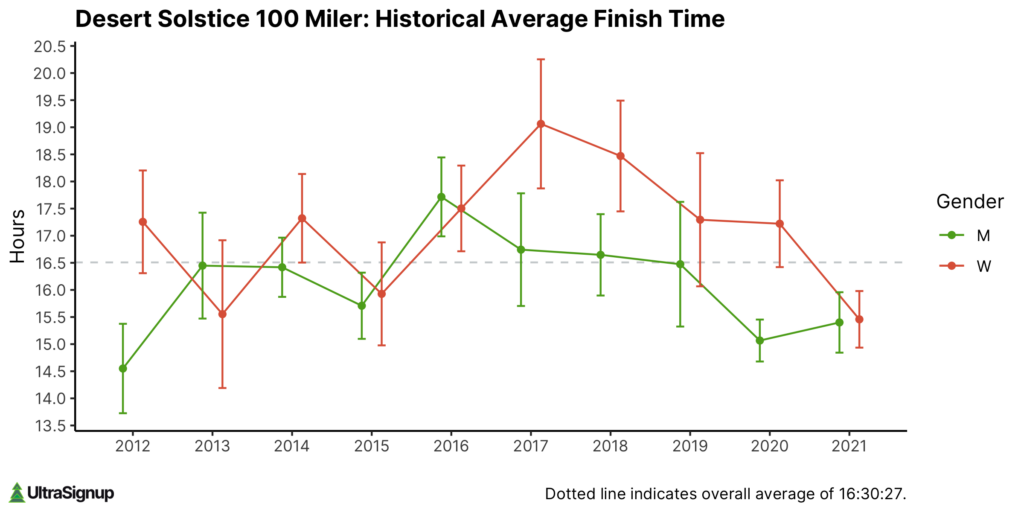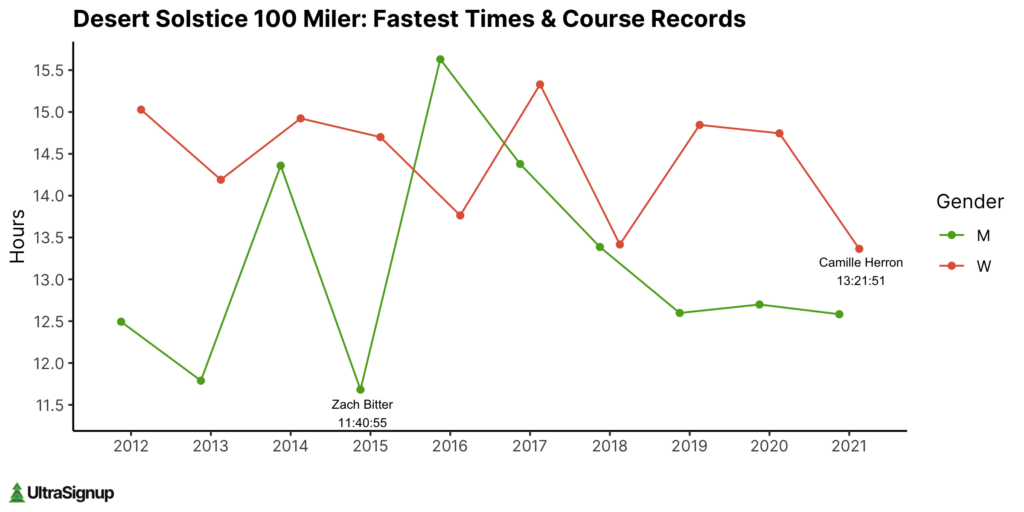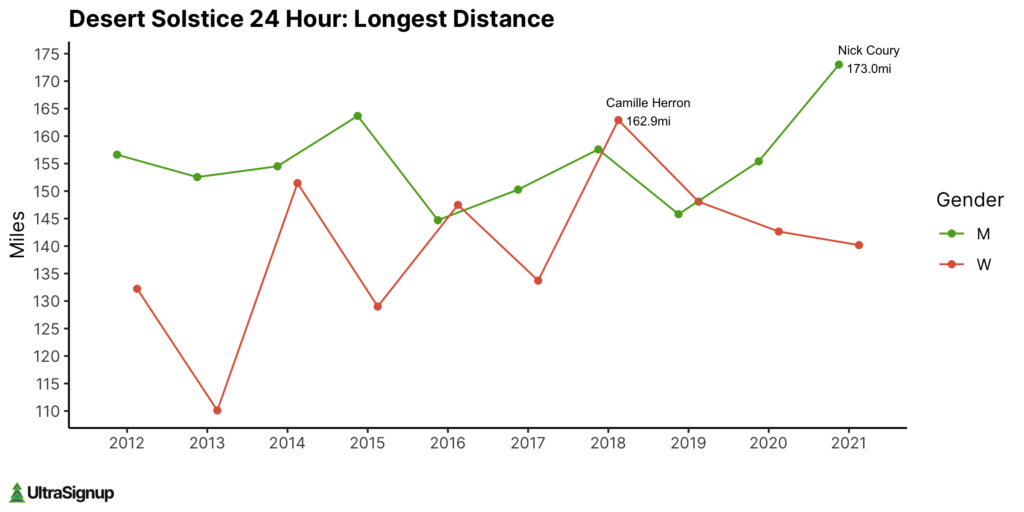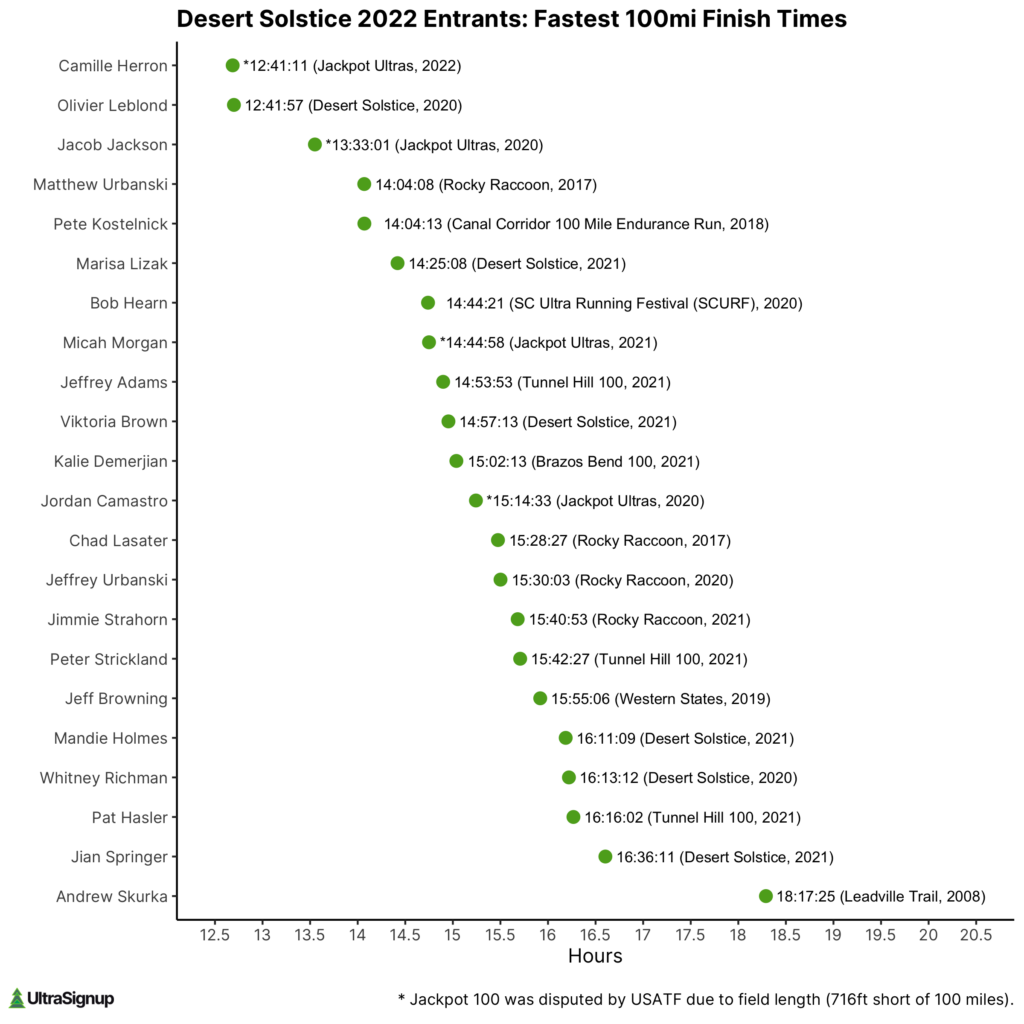Will we see another 100 mile world record?
Desert Solstice is an exciting year-end event where athletes come together to make their dreams come true and break records. This elite, invitational-only 100-mile race and 24-hour timed event hosted each year by Aravaipa Running on the Central High School Track in Phoenix, AZ, is on December 10th, 2022. Aravaipa describes it as a “competitive ultrarunning track meet” designed for record setting and qualification for the national 24 Hour team. The field is limited to 30 runners total, and qualifying is extremely difficult. There are separate “A” and “B” qualifying standards for the men’s and women’s divisions respectively; runners who have a race result meeting one or more of the “A” standards since December 1, 2019, can register for the race until it meets capacity, while “B” qualifiers are considered case by case or waitlisted.
Qualification Standards – 24 Hour & 100 Mile. Runners must have met one or more of these criteria since Dec 1, 2019, to qualify.
| Men’s A Standard | Men’s B Standard | Women’s A Standard | Women’s B Standard | |
| 24 Hours (Miles) | 152 | 138 | 137 | 124 |
| 100 Miles (Hours) | 14:00 | 16:10 | 15:35 | 17:30 |
| 100k (Hours) | 7:15 | 8:10 | 8:05 | 8:50 |
| 50 Miles (Hours) | 5:40 | 6:05 | 6:15 | 6:50 |
Source: https://www.aravaiparunning.com/desert-solstice/
Putting the “A” standards into context, running 100 miles in 14:00-15:35 means sustaining 8:24-9:21/mi pace; or 6:48-7:30/mi for 50 miles; or 137-152 miles in 9:28-10:31. I don’t need to do any fancy statistics to convince you — that is blazingly fast. According to UltraSignup’s database only 0.36% of women and 0.27% of men who have completed 100-milers since 12/1/19 meet these criteria.
Accordingly, Aravaipa Running states, “One of the goals of Desert Solstice is to encourage records and top performances by American athletes and others from around the world.” Aravaipa reports 86 national records and 14 world records set at DS over the years, including Camille Herron’s 100-mile track American and World records in 2021 (13:21:51) and Zach Bitter’s American track 100-mile record in 2015 at 11:40:55, among many others (find the full list at Aravaipa’s website here).
Desert Solstice is a Fast Race
Taking the qualification standards and goals of the event into mind, Desert Solstice is of course a fast race. In fact, it is the fastest 100-mile race in UltraSignup’s database, with an average overall time of 16:30:27 (09:54/mi pace). Figure 1 displays year on year average finish times since 2012 (excluding 2011 due to small sample size, n=2). The overall trend isn’t very clear, but from 2017 to present the field has been speeding up incrementally. This tracks with changes Aravaipa has made to the qualification requirements over the years. For instance, back in 2016 there was no A/B distinction, and the men’s and women’s 100-mile standard was updated from 16:10-15:50 and 17:30-17:00, respectively. In 2019, the A/B distinction was introduced: the “A” standards increased the top-end of the field (to the 14:00/15:35 100mi requirements we see today), and the “B” standards reflect the pre-2016 requirements.
“Our general philosophy has been to encourage the highest standards and best performances as possible,” says Aravaipa’s Nick Coury. “This turns out to be a balance of making the standards tight enough to uphold an increasingly competitive field and keep the track from being crowded, with allowing as many capable runners as possible to give it a shot.”
Figure 1: Historical finish times for Desert Solstice.
The points are the average for each respective gender division, and the lines are variability (standard error of the mean); the dotted line indicates the overall average.

We can see exactly Nick’s philosophy playing out here, as in addition to faster average times since 2019 we also see progressively faster first place finishes. Figure 2 lays out the fastest times for the men’s and women’s divisions, respectively. While the men’s field appears to have plateaued since 2019, with no new course record set since Zach Bitter’s 2015 finish, Camille Herron set a new standard for the women’s field in 2021.
Figure 2.

Even more amazing is that while Desert Solstice sets the stage for world-record times at the 100-mile distance, it is also a 24-hour event, and many runners continue well beyond the 100-mile mark. Nick Coury set the current overall and men’s course record in 2018, running 173.0 miles by the time the date had fully cycled at a cool 8:19 pace; in 2018 Camille Herron set the course record for the women’s field with an astounding 162.9 miles (8:50/mi pace).
Figure 3.

2022 Desert Solstice Preview
The 2022 Desert Solstice event has 26 confirmed entrants, with an average Runner Rank of 88.3% and 35 races results listed on UltraSignup (for context, the average runner on USU has a rank of 62.3% and 2-3 races results). These runners have put out some truly incredible performances in 2022 in both fixed-distance and timed events: Jeff Browning finished #1 in Moab 240 at 57:27:57, with the 3rd fastest recorded time on the course; Whitney Richman finished 1st overall with 46.2 miles run in the Piedmont 8 Hour; Amanda Nelson finished 1st overall at Survivorfest Running Event running 130.52 miles on the track, setting two new Canadian records in the process (12 hour distance with 134.025km, and 100 miles at 14:45:51). The full list of Desert Solstice entrants is listed here for your perusal, and an informative table with stats for each runner is listed at the bottom of the page in Table 1.
Given the stacked list of entrants, what can we expect for this year’s Desert Solstice? Of the 26 entrants, 23 have 100-mile finish times listed in USU’s database, and the fastest times from each runner are rank sorted for presentation in Figure 3 (we’ll get to the asterisks in a moment). Camille Herron and Olivier Leblond stand out with sub-13-hour finishes, with Camille’s 12:41:11 finish at Jackpot in 2022, and Leblond’s 12:41:57 at Desert Solstice in 2020.
The asterisks here reference USATF’s dispute of the Jackpot track length in 2022 following what would have been a new world-record set by Camille, after they remeasured the track and found it to be 716 feet short of 100 miles (7 feet short per lap on the track). Now, 716 feet is only a fraction of a mile (13.56%), meaning runners would have run 99.86 miles on the course by the time the clock had stopped. Running 12:41:11, Herron sustained 7:41/mi pace over those 99.86 miles, and assuming she had been able to hold that average pace for just 716 feet longer (and I’m almost positive she could), she would have finished around 12:42:12, about 28 seconds under her previous world-record. So, I leave in the Jackpot finish times with an asterisk knowing these times still reflect a theoretical upper bound on these racers’ capabilities, regardless of the measurement error.
Figure 4. Fastest 100-mile finish times from Desert Solstice 2022 entrants.

I’m hesitant to make specific predictions because I don’t want to jinx anyone, but that recalculation would make Camille’s estimated personal record (PR) time within 15 seconds of Olivier Leblond’s 12:41:57 PR set in 2020. That said, I believe Camille has a very good chance of running the fastest time at Desert Solstice this year, and given her history in the 24hr event, she could also break 162.9 miles.
What are your predictions for this year’s Desert Solstice? Make sure to tune in to Aravaipa’s livestream coverage of the event starting at 7am on Saturday, December 10th. Here is the livestream link.
| Name | Rank | Gender | Age | Last Race on USU | Date | OA | GP | Time / Dist |
| Amanda Nelson | 97.5% | W | 34 | Survivorfest Running Event 24hrs Track | 6/12/22 | 1 | 1 | 130.522mi |
| Marisa Lizak | 96.2% | W | 43 | Spartathlon 245K | 9/30/22 | 8 | 2 | 25:34:18 |
| Kalie Demerjian | 95.1% | W | 26 | 100k World Championships – Berlin 100K | 8/23/22 | 60 | 60 | 8:56:04 |
| Olivier Leblond | 93.5% | M | 50 | Old Dominion 100 Miler | 6/4/22 | 6 | 6 | 20:42:32 |
| Camille Herron | 93.1% | W | 40 | Western States 100 Miler | 6/25/22 | 23 | 8 | 18:51:54 |
| Jacob Jackson | 92.5% | M | 45 | That’s No Moon Ultras & 30K 50 Miler | 9/24/22 | 2 | 1 | 8:32:44 |
| Lindsay Gabow | 92.3% | W | 28 | The Stinger All Comers Track Race 6hrs | 11/12/22 | 6 | 3 | 31.19mi |
| Andrew Skurka | 92.3% | M | 41 | Staunton Rocks! Marathon | 8/28/21 | 3 | 3 | 3:53:50 |
| Jian Springer | 91.2% | W | 51 | Back On The Ranch Trail Run 12hrs | 10/1/22 | 1 | 1 | 71.5mi |
| Jeff Browning | 91.2% | M | 51 | Moab 240 Endurance Run | 10/7/22 | 1 | 1 | 57:27:57 |
| Mandie Holmes | 91.1% | W | 37 | Spartathlon 245K | 9/30/22 | 59 | 11 | 33:12:07 |
| Viktoria Brown | 90.9% | W | 47 | Hainesport Endurance Run 48hrs | 9/3/22 | 2 | 1 | 195.2861mi |
| Micah Morgan | 90.1% | W | 39 | Spartathlon 245K | 9/30/22 | 12 | 3 | 27:24:01 |
| Alyson Allen | 88.8% | W | 40 | FASTtrack 24hr | 1/19/19 | 3 | 1 | 112.496mi |
| Whitney Richman | 88.1% | W | 42 | Piedmont 8 Hour 8hrs | 10/22/22 | 1 | 1 | 46.2mi |
| Chad Lasater | 87.2% | M | 50 | Wasatch 100 | 9/9/22 | 18 | 16 | 26:21:57 |
| Matthew Urbanski | 86.5% | M | 42 | Hardrock 100 Endurance Run | 7/15/22 | 25 | 22 | 34:54:47 |
| Jeffrey Adams | 85.0% | M | 44 | Superior Fall Trail Race 100 Miler | 9/9/22 | 15 | 13 | 27:39:51 |
| Peter Strickland | 84.5% | M | 44 | Tunnel Hill 100 | 11/12/22 | 8 | 7 | 16:09:56 |
| Pat Hasler | 83.6% | M | 33 | The Stinger All Comers Track Race 24hrs | 11/12/22 | 19 | 14 | 83.93mi |
| Jimmie Strahorn | 82.3% | M | 29 | Jackrabbit Jubilee 12hrs | 6/4/22 | 1 | 1 | 73.6mi |
| Bob Hearn | 80.9% | M | 57 | Javelina Jundred 100 Miler | 10/29/22 | 96 | 70 | 22:38:40 |
| Pete Kostelnick | 80.7% | M | 35 | Mogollon Monster 100 | 9/10/22 | 27 | 26 | 30:25:46 |
| Jordan Camastro | 77.7% | M | 40 | The Hennepin Hundred | 10/1/22 | 20 | 17 | 19:53:42 |
| Jeffrey Urbanski | 75.9% | M | 37 | UTMB | 8/30/22 | 493 | 457 | 36:01:32 |
Table 1. Desert Solstice 2022 entrants with last race result listed on UltraSignup sorted by USU Runner Rank.
This is really cool!